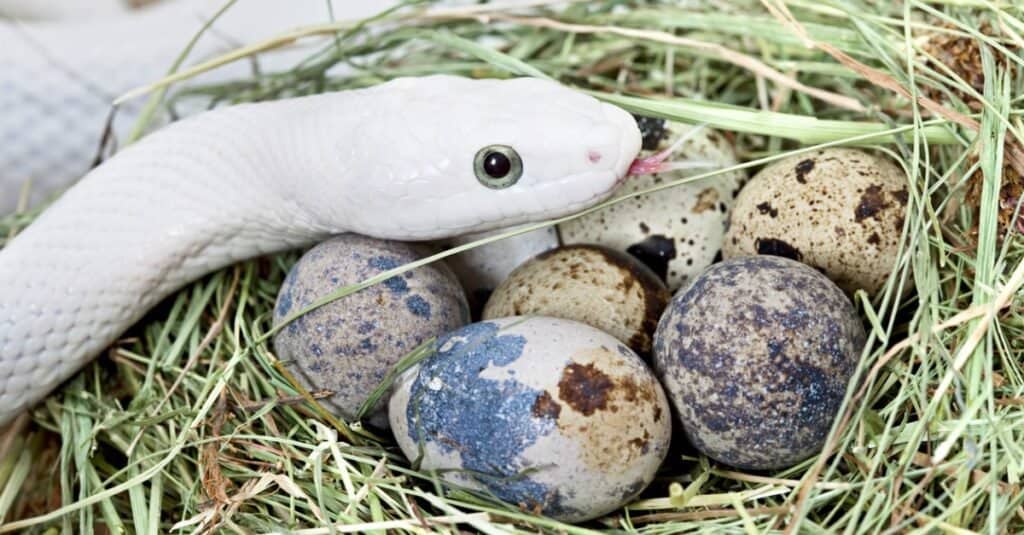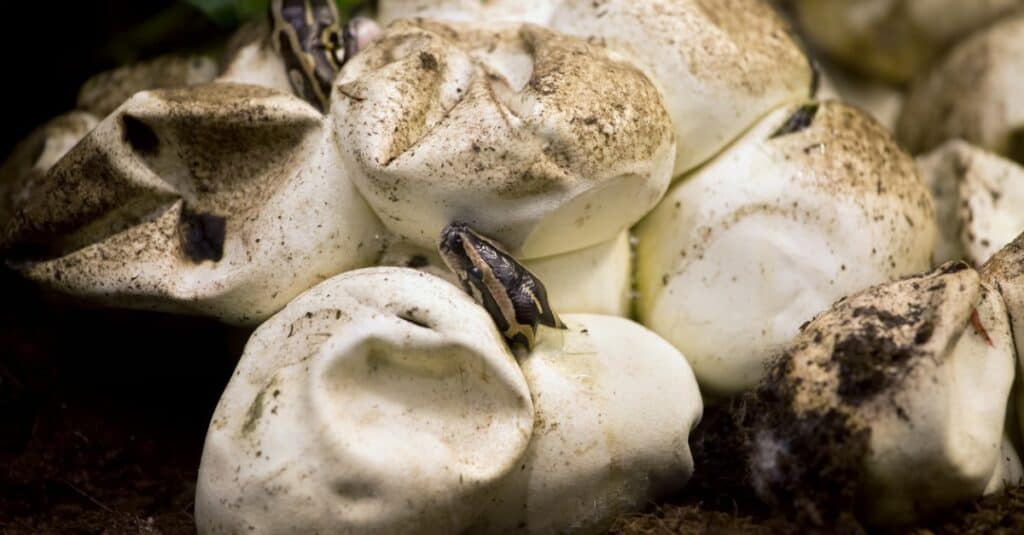Did you know there are about 4,000 species of snake living throughout the world? Certainly, snakes are interesting creatures to observe and study. Some snakes have an array of brightly colored scales while others are dull in color. There are species of snakes that live in the water, on land, or both. Some of the most amazing facts about these reptiles relate to their breeding and egg-laying activities.
Discover facts about the size and color of snake eggs along with where they are usually found. Also, learn about the differences between oviparous, viviparous, and ovoviviparous snakes.
When is the Breeding Season of a Snake?
The breeding season of most snakes is in the springtime from March to May. The breeding period varies depending on the species of snake — and the location! In the southern hemisphere, breeding seasons are in September and October. Northern hemisphere snakes lay their eggs in the early part of summer between June and July.
How Long Do Snake Eggs Incubate?
Though the exact incubation period varies depending on a snake’s species, the average incubation of snake eggs is 57 days. Some snake eggs hatch after 40 days while others don’t hatch until 70 days have passed.
Snake eggs hatch in late summer into early fall from about August to September.
What Do Snake Eggs Look Like?

©iStock.com/alkir
Looking at the shape of an egg can be very helpful in the identification process. Snake eggs have an oblong shape. This allows a developing snake to stretch out within its egg.
The size range of snake eggs is one to five inches. As an example, a Louisiana pine snake claims the title of having the largest snake eggs in the United States. Its eggs are five inches long, and two inches wide. Alternatively, an eastern brown snake’s eggs measure about two inches long.
While the size varies, the color of snake eggs is the same throughout the species. They are either white, off-white, or sometimes beige.
Snake eggs aren’t hard like birds’ eggs. Their surface is flexible and leathery. Most snake eggs even stick together.
What Are the Differences Between Snake Eggs and the Eggs of Other Reptiles?
The identification process is relatively easy when comparing birds’ eggs to snake eggs. Birds have colorful eggs with a variety of designs whereas snake eggs are white or off-white. But, how do you know if the eggs belong to another type of reptile?
One way to differentiate snake eggs from turtle eggs is to look at the shape. A turtle’s eggs are round while a snake’s eggs are oblong.
Observing the size of an egg can also help decide whether it’s a snake’s egg or the egg of another type of reptile. Along with being round, a turtle’s eggs are usually less than one and a half inches in length. While a lizard’s eggs are the same shape as a snake’s, they are usually less than an inch long.
But what about the eggs of a larger reptile-like an alligator? An alligator can have eggs measuring up to three inches long. But their newly laid eggs have a hard, brittle shell as opposed to a leathery texture one like a snake. As an alligator’s eggs incubate, the surface of the shell becomes softer.
In addition, unlike most snakes, an alligator makes a nest for her eggs. Plus, a female alligator stays near her eggs and guards them against predators.
So, as you see, though there are similarities between snake eggs and the eggs of other types of reptiles, there are some differences that can help with identification.
How Many Eggs Does a Snake Lay?
Snakes that are small in size tend to lay fewer eggs than larger snakes. Some small snakes lay as few as two or three up to as many as 30 eggs. A large snake, like a reticulated python can lay 100 eggs or even more in some cases.
Where Do Snakes Lay Their Eggs?

©iStock.com/Dan Olsen
Most snakes don’t make nests for their eggs. They look for a tight space under a rock or an area of ground beneath a ledge. Some snakes lay eggs beneath piles of leaf litter, sticks, or brush. A burrow abandoned by another type of animal is an appealing space where a snake may lay its eggs. The snake wants to find a place for her eggs that is out of sight and protected from changing weather conditions.
One exception is the King cobra. King cobras make a nest out of leaves or other debris by pushing it around with its body. This nest-building activity can be observed both in the wild and in King cobras living in captivity.
Do All Snakes Lay Eggs?
No, not all snakes lay eggs. This is one of those facts that may be surprising. Snakes that lay eggs are known as oviparous. Alternatively, snakes that give live birth are called viviparous. The babies of a viviparous snake develop in a placenta inside the female’s body. This is similar to how mammals carry their young and give birth. Some examples of viviparous snakes include boa constrictors and anacondas.
A garter snake is neither oviparous nor viviparous. Instead, these small snakes are known as ovoviviparous. This means the eggs both incubate and hatch inside the body of a female garter snake. After the eggs hatch inside her, the mother gives live birth to the young.
An ovoviviparous snake enjoys a couple of advantages. For one, a female snake can protect her young from predators because they are in her body right up until they are born. Secondly, she doesn’t make herself vulnerable to predators by stopping to lay eggs.
How Does a Mother Snake Care for Her Eggs?
An oviparous snake lays a collection, or clutch, of eggs in a burrow or beneath a pile of leaves or sticks. But, what happens after that?
Many snakes leave their clutch of eggs right after laying them. This means most baby snakes don’t ever see their mother. Fortunately, the very young snakes can survive on their own immediately after hatching. Of course, there are always exceptions to take into account, especially in the world of animals.
African rock pythons lay their eggs and stay with them for about two weeks after they hatch. The female guards her clutch of 100 or more eggs until they hatch and shed their skin for the very first time. Female African rock pythons are known to attack predators threatening their eggs or their young snakes. You may have seen a picture of an African python snake coiled around a clutch of eggs.
Interestingly, an adult African rock python can measure almost 12 feet long. Furthermore, these snakes can weigh up to 200 pounds. So, a predator threatening a female’s clutch of eggs would likely be comparable in size to this snake. As well as very brave!
Do Any Animals Prey on Snake Eggs?
Yes. It’s especially easy to prey on snake eggs when the mother leaves them right away. Raccoons, skunks, and hawks are all known to eat snake eggs.
These animals may also prey on hatching or newly hatched snakes. A newborn animal of almost any type is vulnerable to predators especially if its mother is not nearby.
What If You Find a Clutch of Snake Eggs?

©iStock.com/Artur Bogacki
If you live near a wooded area, there’s a chance of encountering a clutch of snake eggs. If this happens, be sure to avoid touching the eggs. Picking up the eggs or simply changing their position just a little bit can cause damage to the developing snake inside the egg and keep it from hatching.
If you discovered the snake eggs while moving around leaf litter, mulch, or sticks, gently put the debris back onto the eggs without disturbing them. The mother knew what she was doing when she laid them in that spot.
Of course, there’s no harm in observing the eggs from a distance. You may even get to see them hatching and slithering out into the world!
Can a Pet Snake Owner Care for a Snake Eggs?
Yes, but it takes some preparation. An owner has to have a proper box for the eggs and know how to regulate the temperature of the box. Humidity is also important in properly incubating a clutch of snake eggs.
An owner can determine whether the eggs are doing well by observing them. For instance, an egg that is white or off-white without any darkening on its surface is healthy. A clutch of large eggs with one or two smaller ones may mean that the smaller ones are not viable. Sometimes the humidity and other conditions inside the egg box can be changed to ensure all of the eggs remain viable. But there’s always a chance that not all the eggs will hatch.
NEXT UP:
- Discover 15 of the World’s Most Incredible Snake Facts. If you like snakes as much as we do you will enjoy these fun facts!
- 7 Snakes that Hunt at Night Did you know that some snakes are night predators?
- How to Tell if a Snake is Poisonous (By Color and More) If you are planning a walk in nature you might like to know how to tell if a snake has dangerous venom.
The photo featured at the top of this post is © iStock.com/Ken Griffiths
Discover the "Monster" Snake 5X Bigger than an Anaconda
Every day A-Z Animals sends out some of the most incredible facts in the world from our free newsletter. Want to discover the 10 most beautiful snakes in the world, a "snake island" where you're never more than 3 feet from danger, or a "monster" snake 5X larger than an anaconda? Then sign up right now and you'll start receiving our daily newsletter absolutely free.
Thank you for reading! Have some feedback for us? Contact the AZ Animals editorial team.







